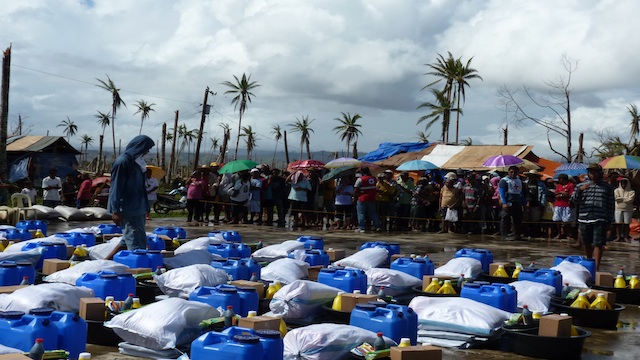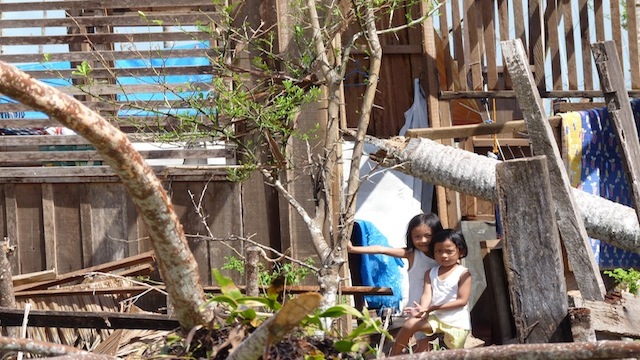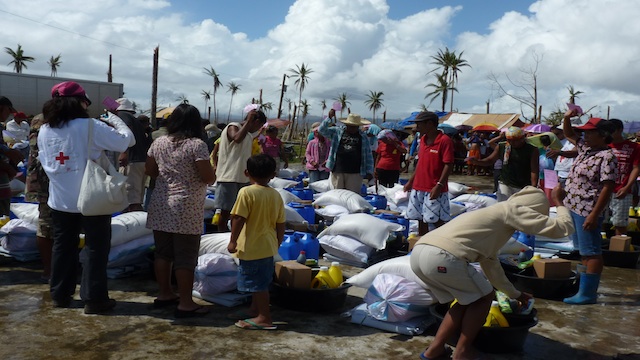SUMMARY
This is AI generated summarization, which may have errors. For context, always refer to the full article.

DAVAO ORIENTAL, Philippines – “Ma’am, pwede pong excuse lang, baka lang po kasi makakuha ako…” (Ma’am, would you please excuse me? I just might be able to get something…)
I quickly nodded “of course,” seeing the approaching bus. And before I could get her name, the woman in the pink T-shirt dashed off to meet the bus bringing relief goods.
The woman in the pink T-shirt, like the over 100,000 of those living in the municipality of Boston, Cateel and Baganga, was left with nothing. Against the super typhoon that was Pablo, the roofs of their homes were reduced to sheets of paper and carried away by the strong wind, their crops were totally destroyed, and even coconut trees were ripped from their roots and scattered in piles on the ground.
With their leaves shaven and only their thin trunks left, they looked more like match sticks than gently leaning coconut trees whose leaves were swaying in the breeze.
The woman in the pink T-shirt and her family were squeezed into the only portion of their home that remained standing with a only a sheet of tarpaulin to serve as a roof.
Pablo left them with nothing, but it could not take away her manners, her courtesy to politely excuse herself before cutting our conversation short.
Waiting
Later that day, people patiently waited for distribution of food and other supplies by the International Committee of the Red Cross (ICRC) and the Philippine National Red Cross (PNRC).
Some had umbrellas, which served the dual purpose of protecting them from the sun and the rain. The weather’s maddening ambivalence made it almost impossible to guess what the sky would bring in next.
They waited patiently as the PNRC volunteers lined up the concrete patch with relief goods. The patch was one of the few remaining surfaces that wasn’t muddy.
In assembly line fashion, gray tarpaulins and blue water containers were lined up, followed by much-needed food items like rice, oil and other everyday items like toothpaste, toothbrushes and shampoo. We often take them for granted, but realize how invaluable they are when a disaster takes away everything.
When the concrete patch was filled up, the first batch of beneficiaries quietly walked beside each completed distribution set, raised their beneficiary cards, collected their kits and exited at the opposite side. The concrete patch was empty and the assembly line started again, while the next batch of beneficiaries awaited their turn.

It was order and organization that spelled the difference between emergency relief assistance and a dole-out.
Mary Ann Cabunyas, a 34-year-old mother of two kids aged 6 and 5, was among the beneficiaries waiting in line.
The wind took their roof and left her home in tatters. She and her family sought shelter in higher ground and at one point, she thought she had lost one of her children in the chaos and the darkness.
“Wala kaming bubong. Mainit tapos maulan,” Cabunyas said. (We lost our roof. It was hot and then it would rain.)
The supplies, particularly the tarpaulins, would be helpful for Cabunyas. One of her kids was running a high fever, but she decided to let the others get ahead of her in line. “Marami pa silang nakapila. Makakakuha rin naman ako.” (There are a lot of people still in line. I know I’ll get my share soon enough.)

It had been close to two weeks since Pablo made landfall and toppled everything in its path. It left residents with nothing, but it could not take away their patience and their sense of fairness.
Organized and mobilized
Quiet and orderly efficiency was evident in the daily debriefings among government and aid agencies.
The Department of Public Works and Highways (DPWH) compound in the municipality of Baganga had been converted into an Incident Command Post where the various organizations had literally set up camp.
Every night the various government and aid agencies would meet to update each other on the progress they were making in their respective areas of responsibility or clusters.
The meetings were presided over by the Philippine Army, headed by Lt Col Krishnamurti Mortela, who with a sense of urgency devoid of arrogance of annoyance, called on each committee to scale up their operations, gently nudging the other aid agencies for more assistance where and when it was needed.
A second lieutenant was taking down notes and flashing them on the screen for everyone to see, but Mortela knew most of the information by heart. He remembered commitments made, the scheduled arrivals of other officials and incoming delivery of relief goods.
I remembered my own father who served in the Philippine Army as a doctor for almost 35 years – all his adult life. He had known no other work except the army.
He never spoke to us, his daughters, about what he saw in the field during his years of service, except to occasionally say out of the blue, “Ang susuwerte nyo. Hindi nyo lang alam kung gaano, may mga tao na walang-wala talaga.” (You girls are so lucky. You don’t know how lucky, there are some people who really have nothing.)

Quiet dignity
The area of eastern Mindanao, ravaged by Pablo, is unused to typhoons. The last time a weather disturbance of this magnitude hit them was 1912 – 100 years ago. In the municipalities of Boston, Baganga and Cateel, people move about in a seeming trance, in stunned silence.
I couldn’t help but remember the note that I had seen scrawled on what might have been a wall or a door – the degree of devastation made it difficult to tell – marami pong salamat sa lahat ng tumulong. (Thank you very much to everyone who helped.)
Pablo may have taken everything from them, but it could not take away their sense of gratitude. It is their quiet dignity in the middle of a disaster that is the mark of their resilience. – Rappler.com
Rappler’s “Text to Help” campaign makes helping as easy as sending a text message.
Add a comment
How does this make you feel?
There are no comments yet. Add your comment to start the conversation.